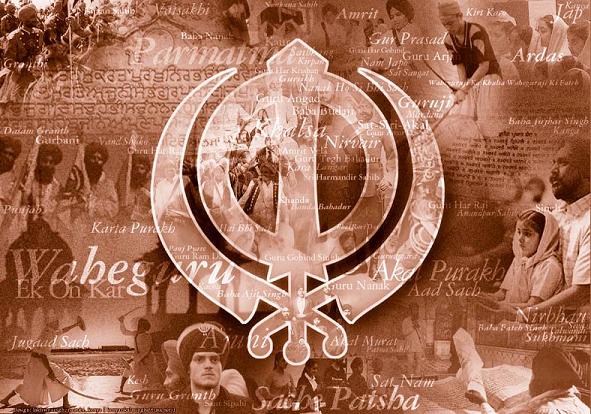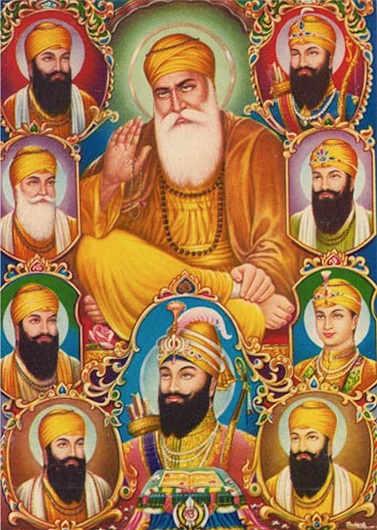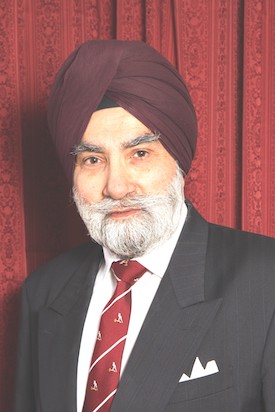Historical background
The 15th century marked the beginning of a new era in history. In Europe, the period saw the start of the overlapping and successive ages of exploration, discovery and inventions leading to the industrial and socio-political revolutions. Progress towards the age of science and information technology was rapid and continues today at an ever-rapid pace.
Copernicus (1473 – 1543) showed that it is not the earth but the sun which is at the centre of the planets. Columbus (1451 – 1506) set sail in 1492 to discover the American continents. Galileo Galilei (1564 – 1642) regarded as the “father of modern science” and other scientists and inventors followed. There were numerous advances in the fields of navigation, astronomy, engineering and science. This was also the start of the age of reason and the process of globalisation of human knowledge had started.
Co-incidentally, thousands of miles away, 15th century also saw the arrival of Guru Nanak Sahib (1469 – 1539) in Punjab, the Land of Five Rivers in the north-western Indian subcontinent. The invasions and migrations from the north-west made Punjab the meeting point of many nationalities and cultures.
The Guru referred to the revolutionary developments in human knowledge yet to come in his Bani, the Divine Word. In anticipation of the rapidly changing human condition, he also gave a new direction to human spiritual progress. He set new goals for spiritual advancement while empowering the ordinary man to achieve those goals. His stress was on living this human life to the full in the service of God’s creation. Yet, as an antidote to excessive attachment, he gave pointers to higher levels of spiritual attainment. Above this level of human existence, he vividly described four higher levels of spiritual experience leading to the ultimate goal of the realm of Truth, the Sach Khand.
This was the time when the global need was for a revolutionary change in religious, social, economic and political thought to respond to the challenges of the new era, also called the Age of Kalyug in Vedic lore. This is the age of spiritual decline due to exploitation, mindless pursuit of pleasure, political power and material gain. Lust, anger, greed, attachment and egotism, breakdown of relationships and social values are the causes of human mental and physical suffering in the Age of Kalyug.
Guru Nanak, the prophet of the Age of Kalyug, had arrived to alleviate human suffering and to show the way to the achievement of the main purpose of this human life.
Quite uniquely amongst the founders of world religions, Guru Nanak took his questioning approach to religious centres far and wide in many countries. He questioned their practices and gave his own convincing answers suggesting best practice which relied on truth alone. He condemned exploitation of ordinary people by the priestly class through complex ritualism and superstition-spreading practices. He exposed the hypocrisy of the opt-out eastern systems which led to worthless and wasted lives. Instead, he extolled the virtues of responsible family life of a working householder earning an honest living.
He reconciled reason with matters of faith, and spiritual progress with temporal needs for harmonious living. His model was the Nirmal Panth, the path of purity and truthful living.
Guru Nanak’s Nirmal Panth
In the Sikh tradition, Gurbani, Guru’s Word in poetic meter, is enshrined in Sri Guru Granth Sahib. It is the primary source for seeking the Guru’s guidance. Gurbani is soul-stirring and stimulates both, the cognitive and connotative processes of the mind. The most authoritative source for interpreting Gurbani is the Vaaran of Bhai Gurdas who wrote, “The Great Mother Earth (Mata Dharat Mahat) was crying out under the weight of those ungrateful (akiratghan) people who had forgotten the True Name of the Creator Being (Satt Naam) and were following false paths.” In those conditions, Guru Nanak rose ( jagg mahe ptthaaya) to prepare those who would follow his path for the challenges which lay ahead by introducing a sovereign new system apart from the Vedic and Semitic traditions.
His liberating ideology empowered ordinary human beings to seek knowledge and union with the Creator Being in this life time.
According to Bhai Gurdas, the Muslim ulama, the brahaman or pandit, the yogi, the sidh, the jain monks etc all were misguiding humanity. The need the Guru felt was for a new whole-life system with a socio-political objective, the establishment of a benevolent just regime in which no one inflicted pain on another. Fifth Nanak, Guru Arjan, referred to this regime as halemi raj. The Guru exhorted his Sikhs to be prepared to make supreme sacrifices to work towards such an ideal human society.
Guru Nanak’s start was the unique description of the Creator Being, the Timeless Self-Aware Infinite Energy: One Creater, Truth is the Name, the Creator Being (Purakh), without fear, without hatred, everlasting, unborn, self-existent, realized through the Guru (i.e. through Creator’s Own Grace, for the Creator is the Dispeller of Darkness i.e. the Guru, the Primal Teacher.)
By bringing the Creator and the created together and thus uniting diversity of creation, this unique description of the Creator called the Mool Mantar (the founding precept or formula) laid the foundation for a model egalitarian human society. Two Godly qualities of being without fear (nirbhao) and without animosity (nirvair), provide the human interface with God. These are the two qualities human beings can cultivate in their daily lives. They can experience God by being without fear or hatred so that no-one is a stranger or an enemy, and achieve the ultimate goal of this life. This goal of the Sikh teachings is to lose the individual egocentric self in the Universal Being through constant awareness of His presence by remembering and learning from his qualities and virtues and by understanding and abiding by his Will (Hukam or Rza).
The One Timeless Creator Being is manifest in all creation, The Creator and the created are united in the diversity of creation. All are equal before the Creator. The ego-centricity of the prophets and the mythological gods and goddesses who put themselves between the Creator and humanity was exposed by the Guru. Thus, he laid the foundation of a whole new way of life called Sikhi. (Sikhism is not a Sikh word.)
Just like an artist who brings to life a new picture by using the same brush strokes, so did the Guru use the same popular language, idiom, and folk-lore to introduce revolutionary new thought which swept aside the darkness of the old religions. “All the sects, pirs, paigambars of the Hindus and Muslims were seen (by Baba Nanak). He concluded that these were the blind leading the blind. Through the power of the Word, the Shabad, he conquered the siddhs and propounded his altogether new way of life.” (Vaar 1 Paoris 26 &31).
He rejected the Islamic and Hindu clergy and the Yogic cults. One quotation from Guru Nanak Sahib’s Bani is:
ਕਾਦੀ ਕੂੜੁ ਬੋਲਿ ਮਲੁ ਖਾਇ ॥ ਬ੍ਰਾਹਮਣੁ ਨਾਵੈ ਜੀਆ ਘਾਇ ॥ ਜੋਗੀ ਜੁਗਤਿ ਨ ਜਾਣੈ ਅੰਧੁ ॥ ਤੀਨੇ ਓਜਾੜੇ ਕਾ ਬੰਧੁ ॥੨॥
(SGGS Ang 662)
(Kaadi/Qazi) the Muslim priest-cum-judge who is expected to rule on issues according to the Islamic law, Sharia, (bol-i) speaks (koorr-u) falsehoods and (khaaey = eats) takes ( mal-u = filth) what is forbidden, i.e. quotes wrong authority to unjustly favor or punish people, after taking bribe. Brahmin, the Hindu priest (ghaaey) kills (jeeaa) the creatures, i.e. exploits gullible people for money or offers animal sacrifices, and then (naavai) bathes to display purity. . ( Jogi ) the Yogi who aims to attain union with the Creator, does not ( jaanai ) know ( jugat-i ) the method to attain union, but ( andh-u = blind ) is blinded by material thoughts and pursuits. The methods of ( teeney ) all three are ( bandh-u = bond ) the means for ( ojaarrey = disuse ) self-destruction. 2.
(Interpretation: http://www.sadhsangat.com/category/guru-granth-sahib/)
In his first Vaar, Bhai Gurdas writes,
“Maaria sikka jagat wich, Nanak Nirmal Panth chalaaya.”
Maaria sikka refers to the victory of Naam i.e. constant remembrance and emulation of God qualities and virtues and abiding by God’s Will (Hukam or Rza). Through such a way of life, the Sikhs, those learning from the Guru’s Word, were cleansed of haomai or ego-centricity and the Nirmal Panth (the pure path of truthful conduct) emerged victorious i.e. gained ascendancy over old religions, yogic sects and cults.
Guru Nanak taught that to abide by God’s Will (Hukam), while living a fully participative and active life is to be in heaven. There is no other fear of hell or heaven hereafter for a Sikh.
Therefore, in Guru Nanak’s teachings, none who spread fear or insecurity are spared: the king and his henchmen using terror as an administrative tool; the high caste priest using rituals, superstition and social divisions as his devices for exploitation; the corrupt religious judge selling judgments; and, the religious fanatic who seeks converts to own faith through the power of the sword. And so, he instilled a fearless spirit in his students, his Sikhs who had conquered self and shed the fear of death. They accepted the Guru’s pre-condition for Sikhi, the Sikh way, “If you wish to play the game of (Lord’s) Love, place your head on the palm of your hand (i.e. be fearless) and come my way.” (Guru Nanak, SGGS p.1412)
The scene was set for permanent conflict between corrupt priestly classes and the power-hungry rulers of the day, and the Sikhs of the Guru.
Some main features Guru Nanak’s new path are as follows:
- The three pillars of his new path are: Constant God awareness ( Naam japna), honest living (Kirt Karni) and sharing with those in need (wand shakna).
- The belief that creation is true and not maaya or illusion. Human life is real and has a definite purpose. However, to get attached to life, to believe that it is forever or that we can take away anything with us after death except truthful living, is an illusion.
- To live the life of a house-holder. Monasticism has no place in Sikhi.
- To condemn discrimination in any form whatsoever.
- To reject all self-proclaimed mediators between God and man (the priestly class)
- Not to shun but to control, harness and redirect the human instincts of lust, anger, greed, attachment and vanity: for procreation and living a responsible family life by raising a family, just anger to defend human dignity and the weak, building self confidence, thrift and saving for economic progress and security
- Seeking the wellbeing of all. The principle enshrines the greatest good of all.
- To use the language of the ordinary people for analysing, discussing and preaching religious, social, economic and political issues. Thereby, empowering the ordinary people to learn – a “Sikh” means a “learner” - and be responsible for own destiny.
- Unlike other systems like Communism which also addresses inequalities and recommends socio-political revolution as the solution, Guru Nanak took into account the moral influence in human behavior. His was a slow revolution through persuasion. He brought together the external and spiritual lives of human beings together as one miri-piri discipline. This twin track approach also evolved into the cauldron and the sword (degh-tegh) symbols of the Khalsa – armed defence of an egalitarian and sharing way of life in which there was justice for all.
- Socio-political activism is an essential part of Sikhi living. In his own life-time, Guru Nanak openly challenged infliction of fear by the prince and the priest, cruelty or oppression in any form and in any religious, social, economic or political sphere of life.
The continuity of the Nirmal Panth was assured by Guru Nanak Sahib through successor Guru persons. They carried the same Light (Jote) and used the same methodology (Jugat) of Guru Nanak and showed the way to the Sikhs by own example. Thus, despite ten Guru persons, the Guru is a singular concept in Sikhi (Sikhism).
The progress continued through the establishment of Sikh institutions, the strengthening of Sikh organisation through Sikh Sangats established by Guru Nanak. The theo-temporal tradition ensured defence and further expansion and evolution of the Nirmal Panth to emerge as the well-disciplined niara (distinct and sovereign) Khalsa.
That is the Message of the Guru’s Bani which laid the foundation of a Nirmal Panth to emerge (pragtio) as the Khalsa Panth – meaning the same as Nirmal Panth i.e. the Order of the Pure or those directly linked with the Creator Being without any intermediary. Khalsa Panth referred to both, the complete sovereign theo-political system founded by Guru Nanak as well as to the Order of the Khalsa, the ordinary people empowered by the Guru’s ideology and institutions to free themselves from all forms of exploitation. Thus, a sovereign theo-political nation was established in 1699 CE by the Tenth Nanak, Guru Gobind Singh.
The process took over 200 years. This was the Guru-tuition period from the time when Guru Nanak Sahib started his mission ( Charria sodhan dharat lokaaee according to Bhai Gurdas) towards the end of the 15th century to the high point of Sikhi tradition, the Khalsa Vaisakhi of 1699.
While the enduring universal principles of the earlier religions became part of Guru Nanak’s Nirmal Panth, there is little doubt that the Guru rejected most practices and rituals associated with older religions. It is not surprising that in the first part of the 20 th Century, Dr Ambedkar faced with religio-social choices and challenges as a dalit, also studied and unequivocally rejected Hinduism and Islam.
When compelled to respond to Hindu claims to Sikhi being part of Hinduism, Bhai Kahn Singh Nabha wrote,
“We do not accept the authority of the Vedas, neither that of Simritis and Puranas. We worship neither Bhairva, nor Ganesha. We recognize neither Tithis nor Omens, nor days. Neither Rahu, Ketu, Shani, Shukar, Sun nor Moon. We do not believe a bit in Sandhya, Sutak, Caste, Varna, Jantar, Mantar, Fasting, Homa or Shradh.Disciples of the Tenth Master, Khalsa Panth is distinct.”
(Ham Hindu Nahi)
The experience of ordinary people in the two Khalsa regimes of Baba Banda Singh Bahdur and Maharaja Ranjit Singh provide a sharp contrast to other religion-based states. Today’s religious wars in the Middle East and massacre and oppression of minorities in India and other countries, show that unlike Guru Nanak’s Sikhi, orthodox world religions remain incapable of guiding their followers back to the concept of one human race. Their scriptures need to be painstakingly re-constructed by moderate modern scholars to derive universal human values.
It takes a paradigm shift to see a new image in the same art work. That revelation is experienced by rejecting all previous beliefs. It takes a reborn mar-jeevra to wake up to the new reality of Guru Nanak’s Nirmal Panth.
Conclusion
Today, we need to reflect seriously on the state of the Guru’s Panth. With reference to the Nirmal Panth of Guru Nanak, I would like to quote Dr Karminder Singh of Malaysia, “The uniqueness of Sikhi was total and complete. Every aspect of Sikh Spirituality was uniquely different from the then existing ones ”. However, deliberate attempts to distort Sikh ideology started almost immediately and continue to this day by the “… Udasis, Nirmalas and Dera Sants to take Sikhi back to the same crossroads at which Guru Nanak stood in 1469 – but steer it in the direction that Guru Nanak chose to avoid.”
However, to conclude on a positive note as we celebrate the 550 th Parkaash anniversary, of Guru Nanak Sahib, there seems to be a renewed sense of urgency to re-discover the sovereign Nirmal Panth of Guru Nanak from the forces of Hindutva and the clutches of derawadi cults .
© Copyright Gurmukh Singh (U.K.)
E-mail: sewauk2005@yahoo.co.uk
Please acknowledge quotations from this article
Articles may be published subject to prior approval by the author


